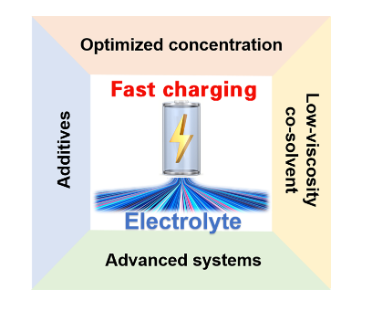《Fast-Charging of Lithium-Ion Batteries: A Review of Electrolyte Design Aspects》
Lithium-ion batteries (LIBs) with fast charging capabilities are expected to overcome the problem of "range anxiety" in electric vehicles and further promote the development of electric vehicles. The Advanced Battery Alliance has set a goal of fast charging, which requires 80% of the battery to be charged in 15 minutes. However, the polarization effect under fast charging conditions can lead to problems such as electrode structure degradation, electrolyte side reactions, lithium plating, and temperature rise, which are closely related to the thermodynamic and kinetic properties of the electrolyte. Traditional organic electrolytes used in lithium-ion batteries are made up of carbonates, which cannot support fast charging without compromising performance and longevity. This review provides an overview of the challenges faced by fast charging of LIBs and the requirements for electrolytes suitable for fast charging. In addition, the latest developments of fast-charging lytes are summarized from four key perspectives: electrolyte additives, low-viscosity co-solvents, high-concentration or locally high-concentration electrolytes, and advanced electrolytes. In addition, this review provides insights into the design of fast-charging lysers based on the mechanism of the charging process, and provides an overview of the current status and future development directions of the field.

https://onlinelibrary.wiley.com/doi/10.1002/bte2.20230018
